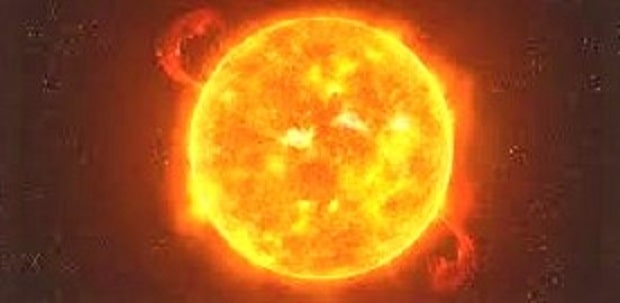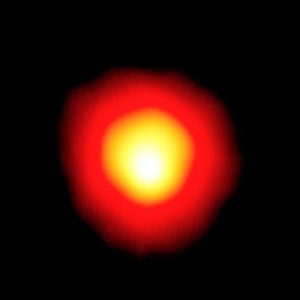
Betelgeuse also called α Orionis, is a star in the constellation Orion. It is also called the shoulder star of Orion. Since October 2019, the brightness of Betelgeuse, one of the brightest stars of the sky, falling inexorably. A descent into hell before his imminent brutal death? This is a suggestion that has appeared in the press in recent weeks, but it does not stand up to further analysis. Besides, according to the latest news, the brilliance of Betelgeuse has been going up since February 21, 2020.
What is Betelgeuse?
Betelgeuse, or the “armpit of the giant” in Arabic, is the reddish star at the top left of the beautiful constellation Orion, visible in the evening in early winter in the direction of the east, and up to in March, when it is then heading west at the start of the night. It is a supergiant star, that is to say, a star of gigantic size.
If its heart were placed in the center of the solar system, its surface would be beyond the orbit of Jupiter. With this gigantic size, we know that it is near the end of its life. Betelgeuse was the second brightest star in the constellation of Orion, but its brightness dropped between October 2019 and February 2020 to reach the radiance of the third ( Bellatrix ), but the radiance of Betelgeuse is now rising.
A succession of fusion of atomic nuclei punctuates the life of the stars
The “life” of a star is made up of a succession of phases of thermonuclear fusions, that is to say, phases during which the star draws its energy from the fusion of light atomic nuclei to form heavier nuclei. Between each of these thermonuclear fusion phases, as the heart collapses, the envelope grows. A star is constantly in search of its equilibrium since the gas which constitutes it tends to collapse on itself due to the attractive force of gravity.
The considerable gas pressures which result from this gravitational force produce very high temperatures at the heart of the star: the temperature of the gas commonly reaches several million degrees there. This high temperature leads to the fusion of atomic nuclei, by the process called thermonuclear fusion. In the heart of the Sun takes place the fusion of hydrogen which, starting from 4 nuclei of hydrogen, produces a nucleus of helium.
[su_youtube url=”https://www.youtube.com/watch?v=k6uODhvkRh8″ width=”240″ height=”200″ title=”the brightness of the Betelgeuse star”]
It is the energy released by this reaction that allows the Sun to radiate light. Let this source of energy run out (following the exhaustion of nuclear fuel), and it is the whole balance of the star which is disturbed. The heart then contracts, while the envelope swells. The contraction of the heart causes its temperature to increase (such as the compressed gas in a bicycle pump), until new fuel can fuse, thereby restoring balance.
A massive supergiant star like Betelgeuse (whose mass is estimated between 15 and 20 times the mass of the sun) has already completed the hydrogen fusion stage, and must then go through the fusion stages of helium, carbon, neon, oxygen, and silicon.
But where is Betelgeuse?
The problem is that the fusion at work at the heart of the star does not leave a signature on the surface. We, therefore, have no idea of the evolutionary stage reached by Betelgeuse. The last stage of combustion, that of silicon producing iron, will last a little more than a day before the final disaster.
This catastrophe is the explosion of the supernova star (called “type II”) – it happens because the fusion of iron can no longer release the energy the star needs to keep its temperatures constant and central pressure despite radiation losses. The iron nucleus constitutes, in fact, the most stable assembly of nucleons existing in nature. Merging two of these nuclei, therefore, requires energy rather than releasing it.
A gigantic fireworks display in perspective, therefore. At a distance of about 650 light-years from Earth, this firework would transform Betelgeuse into a star as bright as the Full Moon for several days, even weeks. A similar event took place in 1054 AD in the constellation Taurus
Have we ever observed star deaths live?
Is the current decrease in the brightness of Betelgeuse the harbinger of this final fireworks display? Nothing is less sure! Unfortunately, we have few precise points of comparison, because the last explosion in the date of type II “near” supernova, that of 1987 in the neighboring galaxy of the Large Magellanic Cloud, did not receive photometric tracking before the explosion, because no pre-explosion signal alerted the astronomical community (with the exception of a neutrino flash arriving about three hours before the light flash). It is true that this occurred at a distance of 168,000 light-years.

Another supergiant star, a potential supernova, is the hull η (Eta) star. In 1837, she presented a major burst of brightness which temporarily transformed her into the brightest star in the sky, and after this burst, she rapidly diminished in brightness to become invisible to the naked eye.
It was not until around 1973 that it became visible to the naked eye. In the question: an ejection of matter, which first absorbed visible light from the surface of the star, which could not pierce the ejected cloud again until it had sufficiently diluted.
Indeed, today we observe around the star η of the Carina and expanding nebula, called “Homunculus nebula“. It is undoubtedly an event of this type that has occurred in recent weeks around Betelgeuse. But the most illuminating case in relation to Betelgeuse was that of a Type II supernova which exploded in a galaxy located 1.2 billion light-years from Earth.
The explosion of this supernova was captured from the first moment by the NASA Kepler satellite in 2011. And this explosion was not preceded by a drop in brightness.
What is the cause of Betelgeuse’s diminished radiance and why is it shining again?
The variation in the brightness of Betelgeuse over the past century has proven complex.
Betelgeuse indeed presents almost periodic variations in luminosity with a dominant period of 420 ± 15 days. But Betelgeuse also shows lower variations in luminosity in the long term (around 2,000 days, or 5.5 years). Currently, its brightness is the weakest that the star has known in almost 40 years. Such a weak brightness was however already recorded in 1941, 1948, 1973, 1980, and 1982, as shown by the light curve of Betelgeuse obtained throughout the 20th century.
These complex variations in luminosity come from pulsations of the envelope as well as from the appearance and disappearance of large convection cells on the surface of the star. In addition, ejection of matter such as that which affected η Carinae can lead to sudden but temporary obscurations.
This last hypothesis is supported by recent images obtained by Miguel Montargès, Pierre Kervella, and their colleagues using the Very Large Telescope of the European Southern Observatory.
The video above reveals that the decrease in brightness of Betelgeuse is caused by the darkening of the lower half of the Betelgeuse disc, linked to gas and large grains of dust, while the image opposite shows the infrared light emitted by the dust surrounding Betelgeuse in December 2019.
The analysis of the event which has affected Betelgeuse in recent months will still require time, but will ultimately allow us to obtain a better understanding of the physical phenomena at work in supergiant stars, the progenitors of type II supernovae. In any event, these events are unlikely to be the harbingers of an impending explosion; it can take place in a month, in a year, in a thousand years, or even in a million years.